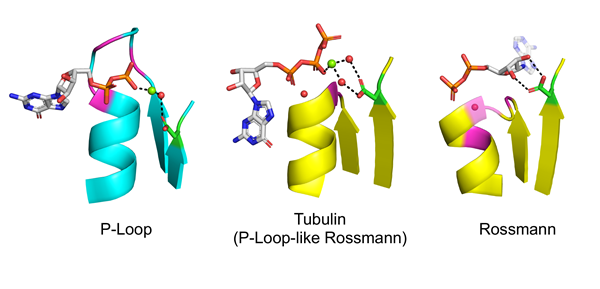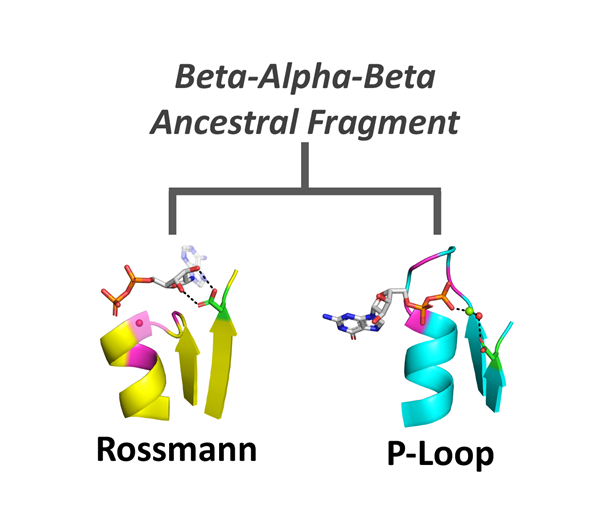Rossmann enzymes and P-Loop enzymes are present in all living organisms and predate the last universal common ancestor or LUCA. Due to their great age – about 4 billion years old! – understanding where these enzymes came from is a daunting challenge. New results, based on a detailed analysis of modern Rossmanns and P-Loops, reveal that these two enzyme families may have evolved from the very same primordial peptide. Furthermore, these data show how intricate protein structures could have emerged from simple primordial peptides – closing the gap between Darwin’s “so simple a beginning” and the profound complexity of the modern biological era.
Proteins are nicknamed the “workhorses of the cell” because they mediate virtually every key cellular process. In most cases, evolutionary relationships between two proteins can be detected by comparing their amino acid sequences. The more similar two sequences are, the more recently they diverged from a common ancestral protein. Proteins for which there is detectable sequence similarity are grouped together in “families”. Although thousands of protein families have been discovered, few are as central to biology as the “Rossmanns” and the “P-Loops”. These two enzyme families form the backbone of cellular metabolism by helping to produce energy-rich molecules and by catalyzing difficult chemical reactions. Furthermore, because Rossmanns and P-Loops are found in every known living organism, they date back to the last universal common ancestor – the cell from which all modern life descended, some four billion years ago. Based on standard sequence analysis approaches, the prevailing scientific consensus is that Rossmanns and P-Loops are not related to each other, and thus have distinct, unique evolutionary histories.
A recent study led by ELSI researcher Dr. Liam Longo and Prof. Dan Tawfik at the Weizmann Institute of Science, however, has called this view into question. By uncovering similarities between the functional cores of both enzymes, this team of researchers demonstrated that Rossmanns and P-Loops may be distant evolutionary cousins that emerged from the same primordial peptide.
For extremely ancient relationships, as would be the case for Rossmanns and P-Loops, any sequence similarity may have been completely lost. As such, alternative approaches to identifying shared ancestry must be developed. To study whether Rossmmans and P-Loops are related, the idea of a “bridge protein” was employed. Bridge proteins occur when the features of one family emerge in the context of another family – that is, when a Rossmann enzyme contains a sequence or structure that is unexpectedly similar to a P-Loop enzyme, or vice versa. The existence of such bridging proteins can be a signature of distant evolutionary relationships, particularly if the bridge segments are localized to key functional sites, which tend to be the most ancient part of an enzyme.

Using an advanced sequence comparison algorithm developed by Rachel Kolodny (University of Haifa, Israel) and Nir Bel-Tal (University of Tel Aviv, Israel), as well as a detailed analysis of known enzyme structures, sequence fragments and structural themes that are shared between Rossmanns and P-Loops were uncovered. An illustrative example is tubulin, best known for building the cytoskeleton of eukaryotic cells, though it is present all throughout the tree of life. Although tubulin is a Rossmann protein, it employs a P-Loop-like structure to catalyze chemical reactions. This structure is achieved by repurposing a key Rossmann functional element, the so-called “beta2-Asp” (see Figure 1). Tubulin, therefore, represents a sort of intermediate between these two protein families. Notably, for each of the proteins with an identified bridging fragment, the region of similarity was the same: the beta-loop-alpha structural element that forms the functional core of these enzymes and lies at the heart of their structures to this very day. The implication is that both Rossmanns and P-Loops may be related and that both enzymes emerged prior to the LUCA from just a single, simple peptide (see Figure 2).

The suggestion that Rossmanns and P-Loops – two of nature’s most important enzymes – emerged from a single peptide is notable because it helps explain how the complexity of modern biology was achieved by evolution: By tinkering with, repurposing, and building upon a functional peptide that emerged at the dawn of life. In this way, one simple fragment can give rise to thousands of enzymes, each with unique properties. Darwin famously wrote that the “wonderous” complexity of modern life emerged “from so simple a beginning”. So too has the wonderous complexity of modern proteins, a story that, at least for Rossmanns and P-Loops, begins with a beta-loop-alpha fragment.
| Journal | eLife |
| Tile of the paper | On the emergence of P-Loop NTPase and Rossmann enzymes from a Beta-Alpha-Beta ancestral fragment |
| Authors | Liam M Longoa,b,c, Jagoda Jabłońskaa, Pratik Vyasa, Manil Kanadea, Rachel Kolodnyd*, Nir Ben-Tald*, Dan S Tawfika* |
| Affiliations | a. Weizmann Institute of Science, Department of Biomolecular Sciences, Rehovot, Israel b. Tokyo Institute of Technology, Earth-Life Science Institute, Tokyo, Japanc. c. Blue Marble Space Institute of Science, Seattle, United States d. University of Haifa, Department of Computer Science, Haifa, Israele. e. Tel Aviv University, George S. Wise Faculty of Life Sciences, Department of Biochemistry and Molecular Biology, Tel Aviv, Israel |
| DOI | 10.7554/eLife.64415 |
| Online published date | Dec 9, 2020 |
